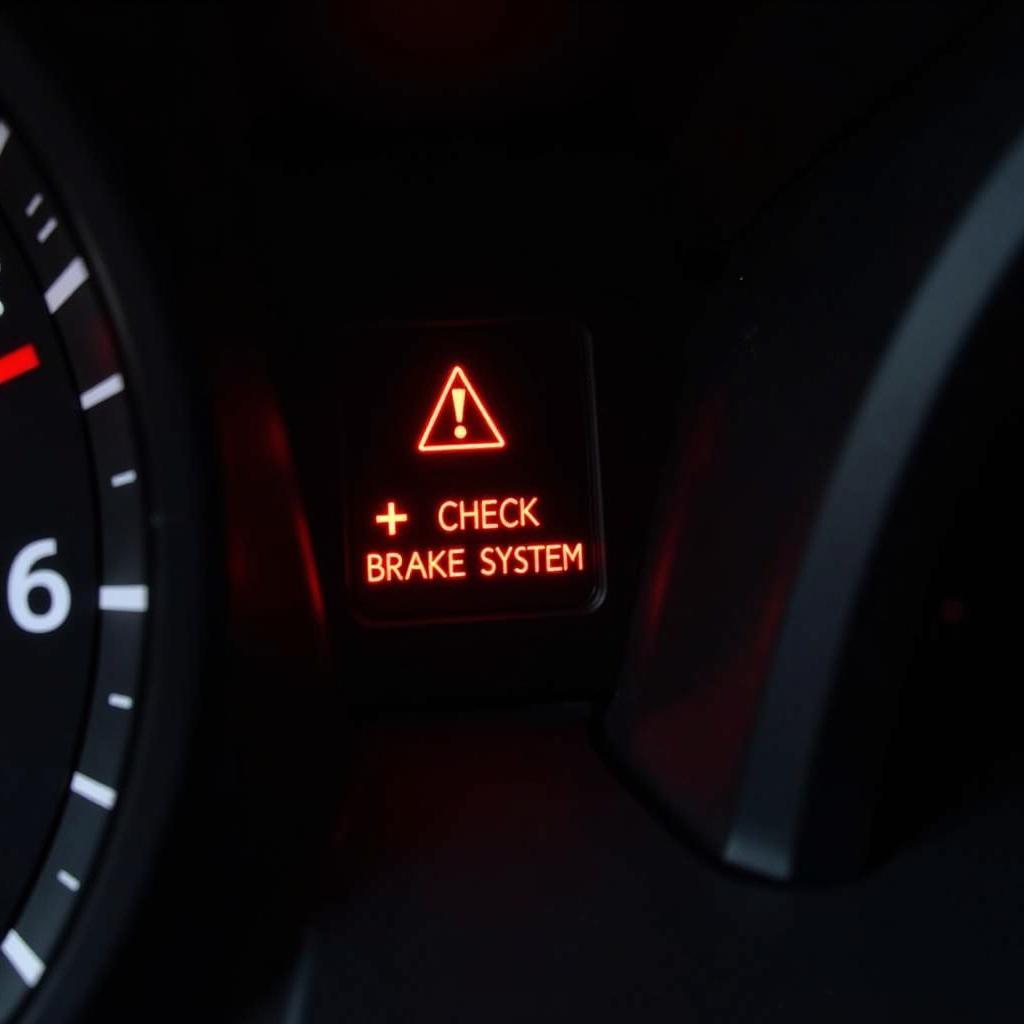The brake service warning light on your 2003 GMC Sierra 1500 is more than just an indicator light; it’s your truck’s way of telling you something needs attention. Ignoring it could lead to decreased braking performance and potentially dangerous situations on the road. This article delves into the common causes behind this warning and provides insights into diagnosing and addressing them.
Understanding Your Truck’s Braking System
Before we dive into the specifics of the brake service warning, it’s helpful to have a basic understanding of how your GMC Sierra 1500’s braking system works. The system is comprised of several key components working in harmony to bring your vehicle to a safe stop:
- Brake Pedal: The interface between you and the braking system, transmitting your input to the master cylinder.
- Master Cylinder: A hydraulic pump that generates pressure when you press the brake pedal.
- Brake Lines: These lines carry the pressurized brake fluid from the master cylinder to the wheels.
- Brake Calipers: The calipers house the brake pads and contain pistons that press the pads against the rotors when you brake.
- Brake Rotors: Large metal discs attached to the wheels. Friction from the brake pads against the rotors generates the stopping power.
When the brake service warning illuminates, it signals a potential issue within this intricate system.
 2003 GMC Sierra 1500 Brake System Diagram
2003 GMC Sierra 1500 Brake System Diagram
Common Causes of the Brake Service Warning
Several factors can trigger the brake service warning on your 2003 GMC Sierra 1500. Here are some of the most common culprits:
1. Worn Brake Pads
Brake pads are designed to wear down over time as they generate friction against the rotors to stop your vehicle. When the pad material wears thin, the brake service warning light will illuminate to alert you it’s time for a replacement.
How to Check: You can visually inspect your brake pads by looking through the spaces between the wheel spokes. If you see less than 1/4 inch of brake pad material remaining, it’s time for a new set.
2. Low Brake Fluid Level
Brake fluid is the lifeblood of your braking system. It transmits the force from the master cylinder to the calipers, activating the brakes. A low brake fluid level is often a sign of a leak in the system, which needs immediate attention.
How to Check: Locate the brake fluid reservoir under the hood (refer to your owner’s manual for the exact location). The reservoir will have a “Min” and “Max” marking. If the fluid level is below the “Min” line, add the appropriate brake fluid (DOT 3 or DOT 4, as specified in your manual). However, if you find yourself frequently adding brake fluid, it’s crucial to have the system inspected for leaks.
3. Faulty ABS Wheel Speed Sensor
The Anti-lock Braking System (ABS) relies on wheel speed sensors to monitor the rotational speed of each wheel. These sensors play a crucial role in preventing wheel lockup during hard braking. A malfunctioning or dirty ABS wheel speed sensor can disrupt this process, triggering the brake service warning light.
How to Check: Diagnosing a faulty ABS sensor often requires specialized diagnostic tools. If you suspect an issue with an ABS sensor, it’s best to consult a qualified mechanic.
 Close-up of Worn Brake Pads on a GMC Sierra 1500
Close-up of Worn Brake Pads on a GMC Sierra 1500
4. Brake Fluid Flush Needed
Over time, brake fluid can absorb moisture from the air, leading to reduced performance and potential corrosion within the braking system. Most manufacturers recommend a brake fluid flush every 2-3 years or as specified in your owner’s manual.
5. Other Less Common Causes
While less frequent, other issues such as a faulty brake light switch, a problem with the master cylinder, or even electrical issues within the vehicle’s wiring can trigger the brake service warning.
Troubleshooting Your Brake Service Warning
If your 2003 GMC Sierra 1500 displays the brake service warning, the first step is to assess the situation:
- Is the warning light steady or flashing? A flashing warning light often indicates a more severe issue, potentially with the ABS system.
- Are there any noticeable changes in braking performance? This could include a soft or spongy brake pedal, longer stopping distances, or unusual noises when applying the brakes.
Based on your observations, you can decide whether to attempt some basic troubleshooting or seek professional assistance.
For Basic Troubleshooting:
- Check the brake fluid level: As mentioned earlier, this is a simple yet crucial step. If the fluid is low, top it up and monitor the level closely. If it drops rapidly, there’s likely a leak in the system.
- Inspect the brake pads: Visual inspection can reveal if the pads are worn and require replacement.
When to Seek Professional Help:
If the warning light persists, flashes, or you notice significant changes in braking performance, it’s vital to have your vehicle inspected by a qualified mechanic. Attempting complex repairs on your braking system without proper knowledge and tools can be dangerous.
Expert Insight
“Remember, your vehicle’s braking system is critical for your safety and the safety of others on the road,” says Mark Williams, a seasoned automotive technician with over 20 years of experience. “Never ignore warning lights related to your brakes. Early detection and maintenance can prevent costly repairs and, most importantly, keep you safe.”
 Mechanic Checking Brake Fluid Level on a GMC Sierra 1500
Mechanic Checking Brake Fluid Level on a GMC Sierra 1500
Conclusion
The brake service warning on your 2003 GMC Sierra 1500 is a serious signal that should never be ignored. While some causes, like worn brake pads, can be addressed with basic maintenance, others require the expertise of a qualified mechanic. Remember, a well-maintained braking system is paramount for safe and confident driving. Regular inspections and timely repairs will ensure your truck’s braking system remains reliable for miles to come.

